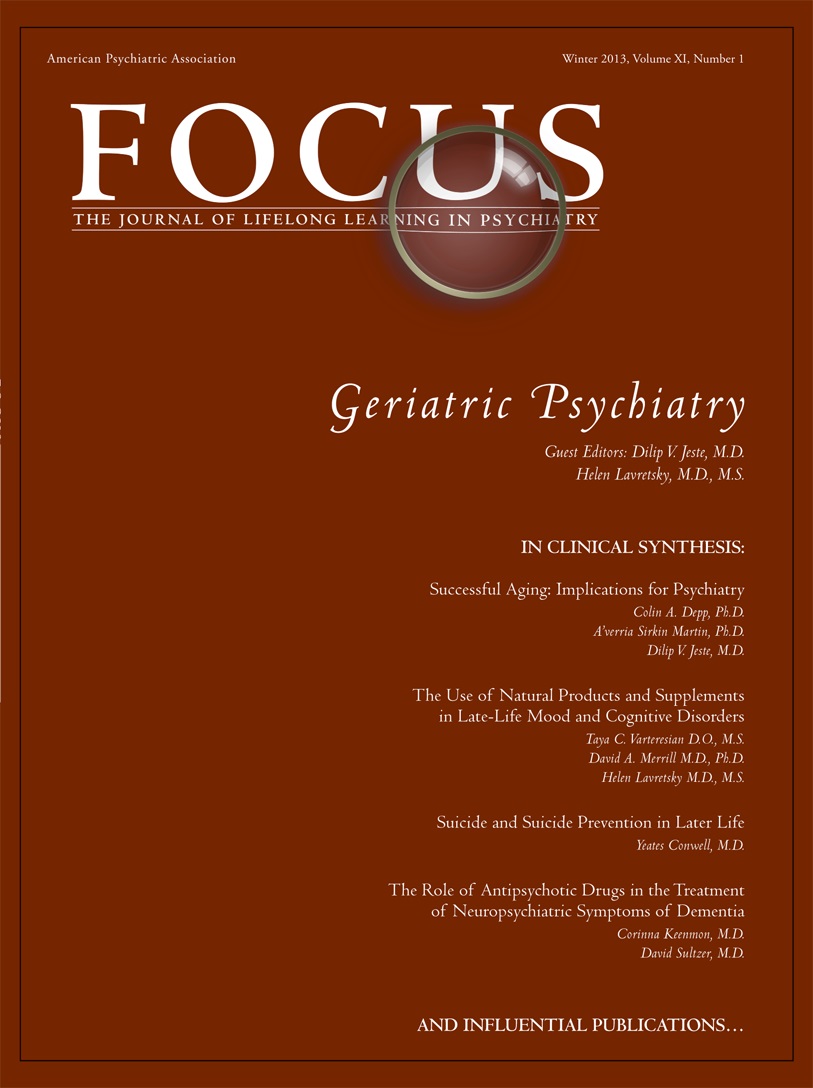The Use of Natural Products and Supplements in Late-Life Mood and Cognitive Disorders
Abstract
Introduction
Omega-3 fatty acids
Mood disorders
Cognitive disorders
SAMe
Mood disorders
Cognitive disorders
St. John’s wort
Mood disorders
Ginkgo biloba
Cognitive disorders
Huperzine A
Cognitive disorders
Vitamin B
Mood disorders
Cognitive disorders
Conclusion
| Mode of Intervention | Postulated Mechanism of Action | Scientific Evidence | Main Adverse Effects and Drug Interactions | |
|---|---|---|---|---|
| Depression | Dementia/Cognition | |||
| St. John’s wort | • MAOI• less 5-HT reuptake• ↓ amyloid production | Approx. 40 RCTs (27–33) with mixed results, some positive and some failed trials | Positive animal studies (60) | • Mania induction (61)• 5-HT syndrome (62)• Photosensitivity (63)• Drug interactions via MAOI & CYP 3A4/2C19 induction (36, 37, 62) |
| Omega-3 fatty acids | • Mood stabilization• Neuroprotection• ↓ amyloid production | Several RCTs (4, 8–10, 13); helpful for clinical depression or bipolar depression but not mania | Several RCTs (14, 15)no prevention of dementia but may slow cognitive decline | • Fishy aftertaste (62)• GI distress (62)• ↑ warfarin & NSAIDs (additive antiplatelet effect) (62)• Mania induction (64) |
| SAMe | • Cofactor in NT synthesis• methylation homocysteine to methionine | Several RCTs; parenteral SAMe is superior to placebo (20, 21, 23); 1 RCT oral SAMe as augmentation strategy (22) | 1 small study showed improvement in MMSE (26)1 RCT suggests better recall w/ depression (27) | • Mania induction (62, 65)• 5-HT syndrome• suicide attempt (66)• GI distress (62)• HA (62) |
| Gingko biloba | • Scavenging free radicals-lowering oxidative stress, reducing neural damages• increased blood flow to the brain | 1 RCT improved depression w/ dementia & sexual side effects from antidepressants (40) | Mixed and negative results in RCTs of dementia and other cognitive disorders (38, 39)Short duration of treatments <6 months | • ↑ bleeding time (41)• allergic reactions (62) |
| Huperzine A | • Anticholinesterase• NMDA antagonist | No studies for mood | Numerous RCTs from China show benefit (43); U.S. RCT showed only modest benefit at high dosage (44) | • Nausea (42) |
| Vitamin B12 and B9 | • Cofactor in NT synthesis• methylation homocysteine → methionine | RCTs are mixed (47–49); B9 is an effective adjunct (50–52) | RCTs are mixed; when no deficiency exists, more robust response in those without dementia (56–58) | • Increased total mortality risk in meta-analysis (59) |
References
Information & Authors
Information
Published In
History
Authors
Funding Information
Metrics & Citations
Metrics
Citations
Export Citations
If you have the appropriate software installed, you can download article citation data to the citation manager of your choice. Simply select your manager software from the list below and click Download.
For more information or tips please see 'Downloading to a citation manager' in the Help menu.
View Options
View options
PDF/EPUB
View PDF/EPUBGet Access
Login options
Already a subscriber? Access your subscription through your login credentials or your institution for full access to this article.
Personal login Institutional Login Open Athens loginNot a subscriber?
PsychiatryOnline subscription options offer access to the DSM-5-TR® library, books, journals, CME, and patient resources. This all-in-one virtual library provides psychiatrists and mental health professionals with key resources for diagnosis, treatment, research, and professional development.
Need more help? PsychiatryOnline Customer Service may be reached by emailing [email protected] or by calling 800-368-5777 (in the U.S.) or 703-907-7322 (outside the U.S.).

